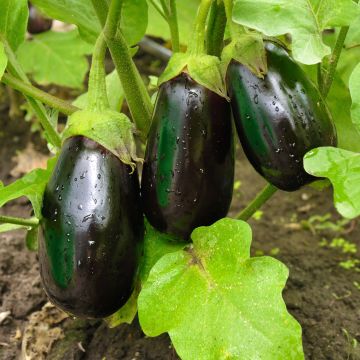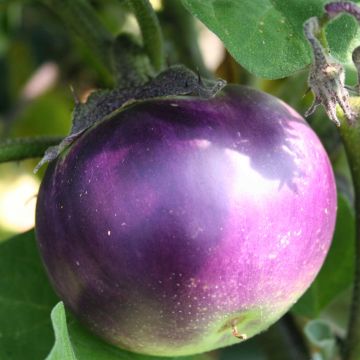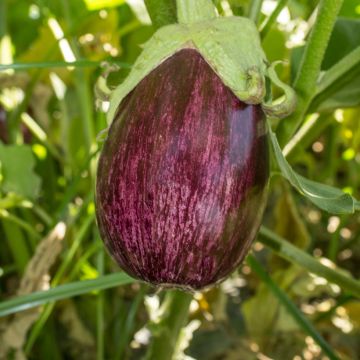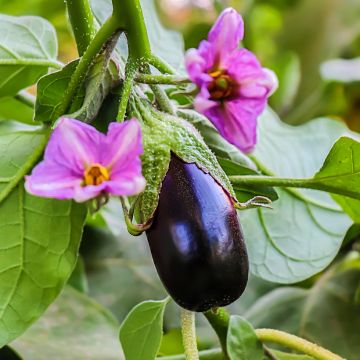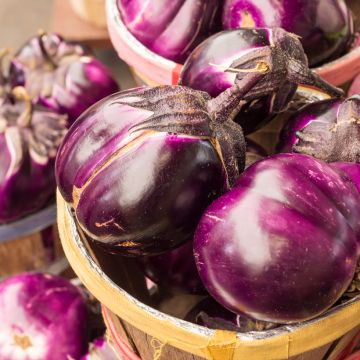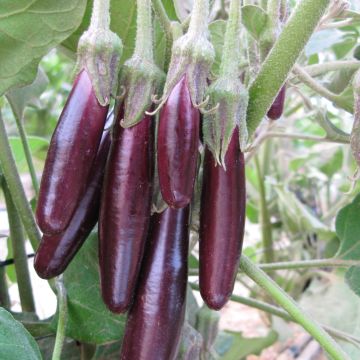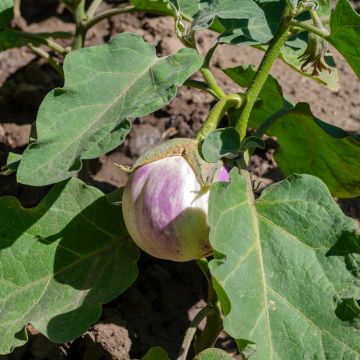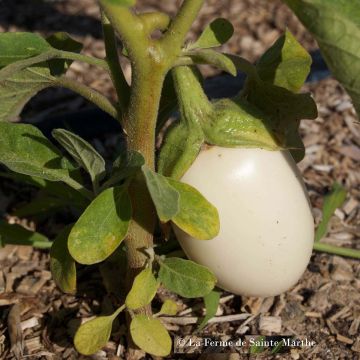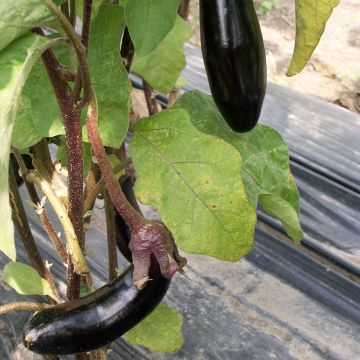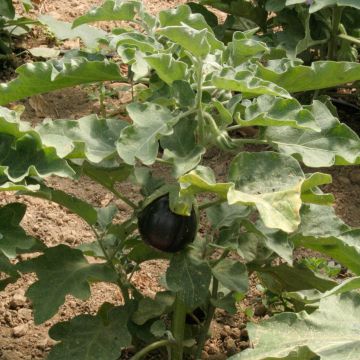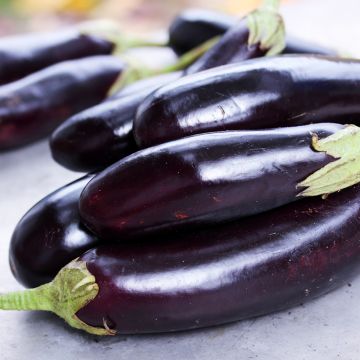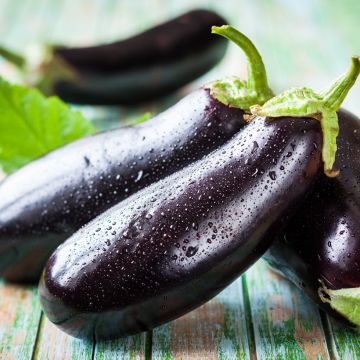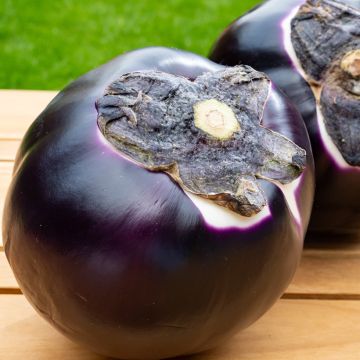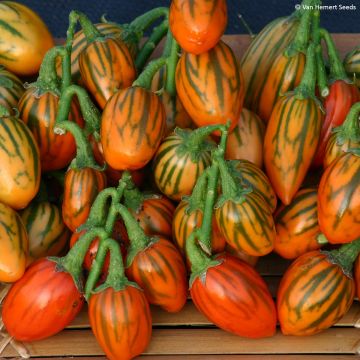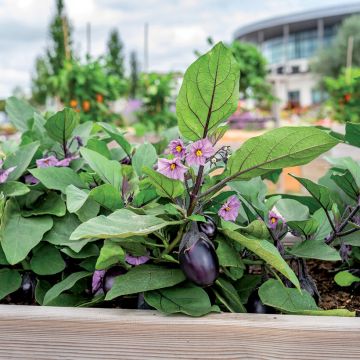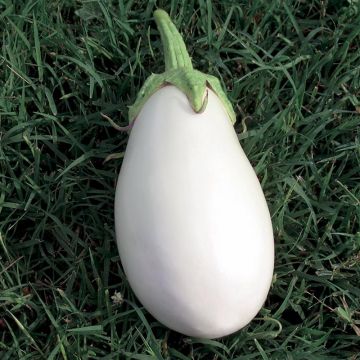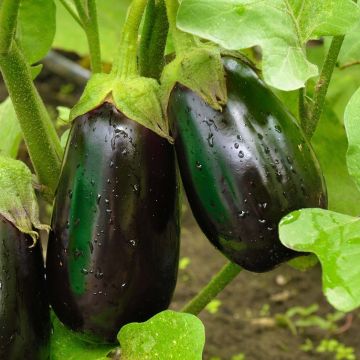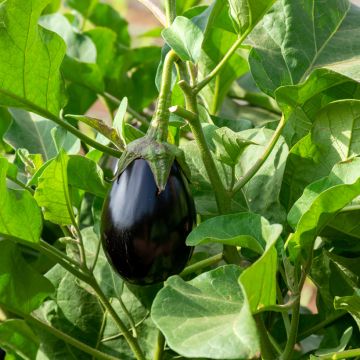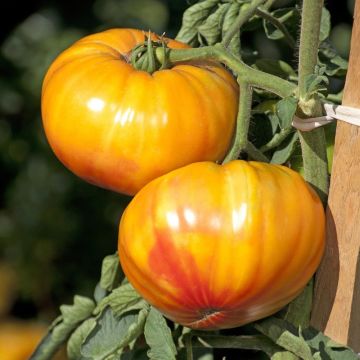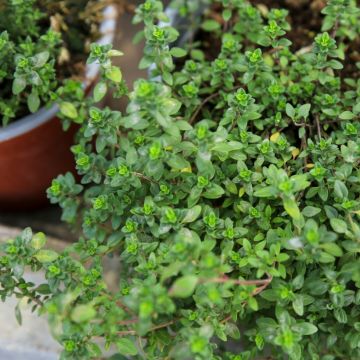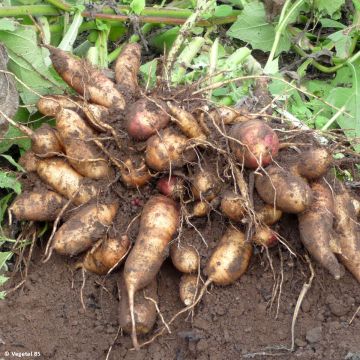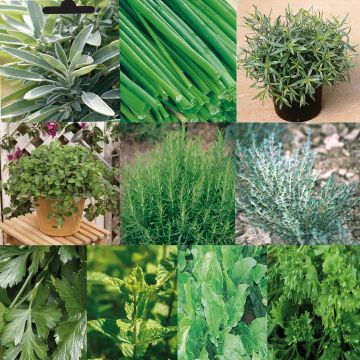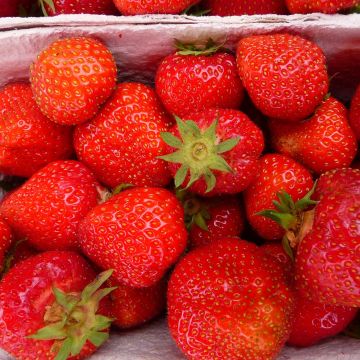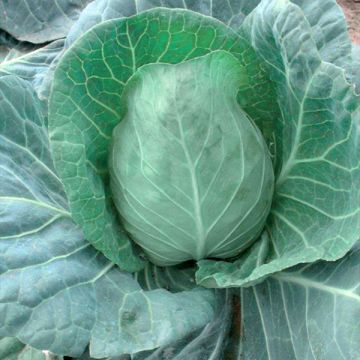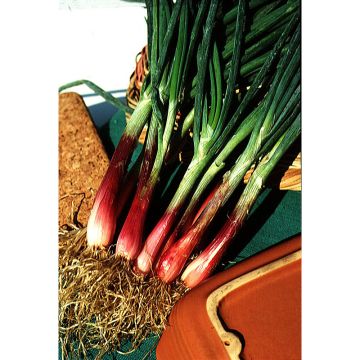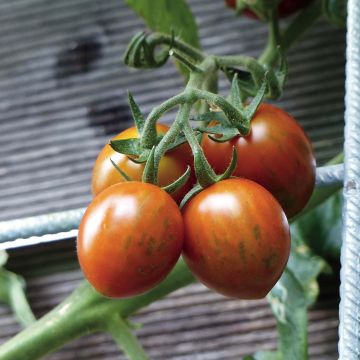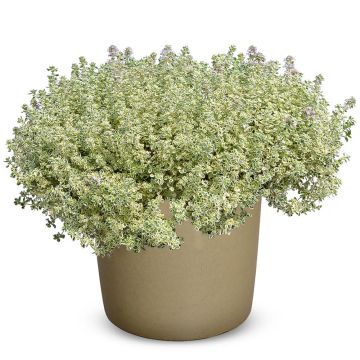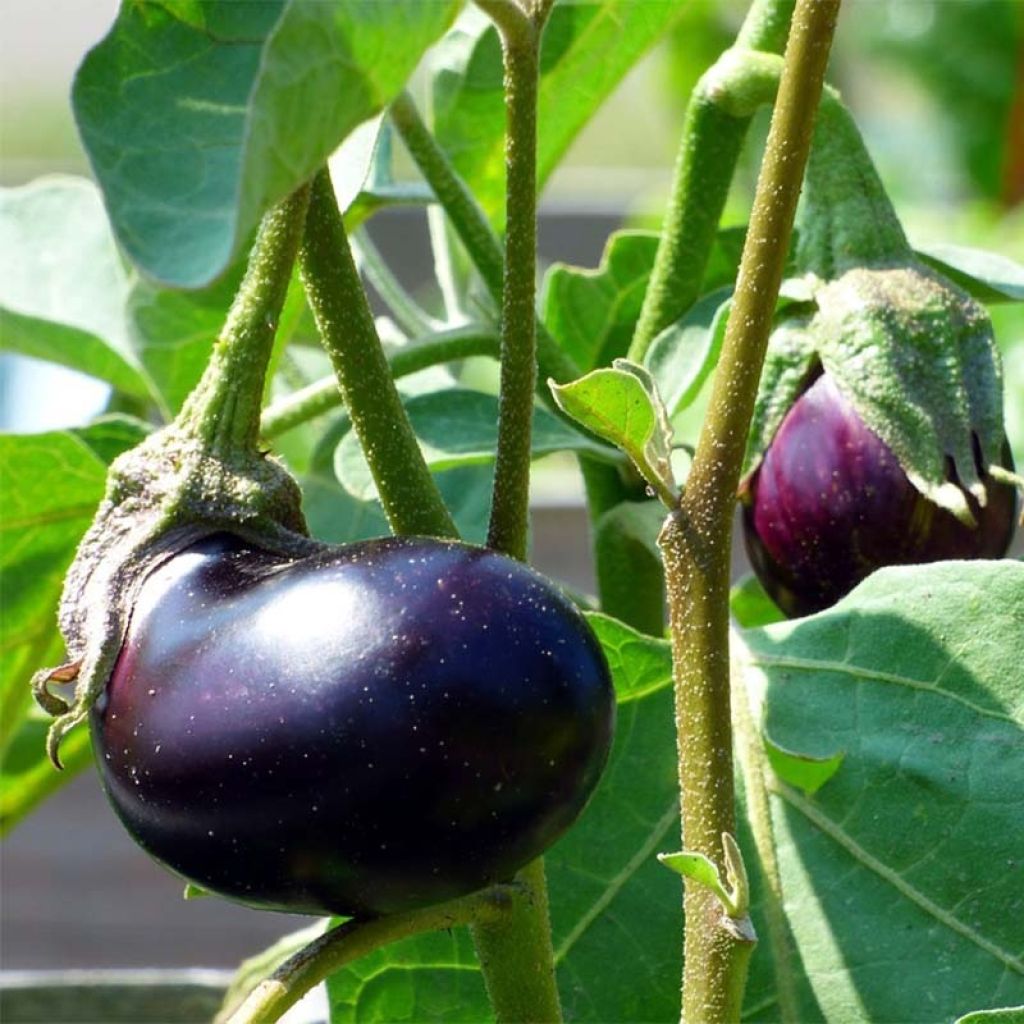

Aubergine Baluroi F1
Aubergine Baluroi F1
Solanum melongena Baluroi F1
Aubergine, Eggplant
Why not try an alternative variety in stock?
View all →This plant carries a 6 months recovery warranty
More information
We guarantee the quality of our plants for a full growing cycle, and will replace at our expense any plant that fails to recover under normal climatic and planting conditions.
From €5.90 for pickup delivery and €6.90 for home delivery
Express home delivery from €8.90.
From €5.90 for pickup delivery and €6.90 for home delivery
Express home delivery from €8.90.

Description
The 'Baluroi' F1 eggplant is a vigorous variety that is resistant to diseases. It produces beautiful elongated fruits, measuring 22 to 25 cm (9 to 10in) in length, with a very dark, shiny purple skin. With a very good taste, its flesh is white and of excellent flavour. You can sow it in March-April and harvest it from July to October.
The eggplant was introduced to Europe in the 14th century in Spain and in the 17th century in France. It has been cultivated in India and China since ancient times. Eggplants are cooked, stuffed, in cream, and in gratin, and is also used in ratatouille. Eggplant has calming and diuretic properties and contains vitamins A, B1, B2, B5, C, and PP, as well as iron and calcium.
Harvest: Between July and October, eggplants are harvested as needed and as they develop.
Storage: Eggplants can be stored for up to a week in the vegetable compartment of the refrigerator. Once steamed, they can be kept in the freezer for 6 to 8 months.
Gardener's tip: Regular weeding and hoeing should be done. Prune the ends of the branches to facilitate fruit enlargement.
Report an error about the product description
Harvest
Plant habit
Foliage
Other Aubergine
Planting and care
Planting:
Grow on the plants by transplanting the plug plants into trays or pots of 8 to 13 cm (3 to 5in) in diameter, filled with compost. Place them in a warm and bright location. Water regularly.
Planting in the ground should be done around mid-May or in June, when the risk of frost has passed. Plant the aubergine in full sun, in a sheltered spot. It thrives in well-drained and rich soils. As the aubergine is a heavy feeder, it will be necessary to add well-rotted compost in the previous autumn. In cooler regions, it is advisable to plant the aubergine in a greenhouse.
Soak the root ball in water for a few moments before planting. Space the plants 50 cm (20in) apart in all directions. Dig a hole, place the root ball and cover with fine soil. Water thoroughly. At the beginning of the growing season, protect the plants with a mini-tunnel or a frame to gain a few degrees.
The aubergine can also be grown in pots, provided it is placed in the sun. In this case, you can plant the plug plants directly into the pot.
Maintenance:
Water regularly, making sure not to wet the foliage to prevent the occurrence of fungal diseases such as mildew. Drip irrigation is well suited.
Diseases and pests:
The aubergine is susceptible, just like the tomato, to mildew. This is a fungal disease caused by the Phytophthora infestans fungus. Mildew develops in hot and humid weather. Small spots appear, white on the underside of the leaves and green-grey on the top. To limit the risks, space the plants sufficiently and do not water the foliage. In terms of rotation, wait 4 years before growing a plant from the Solanaceae family in the same location and do not grow them in neighboring rows. If necessary, spray with Bordeaux mixture or preparations such as horsetail decoction or garlic tea.
Finally, you can protect young plants from slugs and snails by placing ash or coffee grounds nearby, to be renewed after rain.
Cultivation
Care
Intended location
-
, onOrder confirmed
Reply from on Promesse de fleurs
Vegetable plants
Haven't found what you were looking for?
Hardiness is the lowest winter temperature a plant can endure without suffering serious damage or even dying. However, hardiness is affected by location (a sheltered area, such as a patio), protection (winter cover) and soil type (hardiness is improved by well-drained soil).

Photo Sharing Terms & Conditions
In order to encourage gardeners to interact and share their experiences, Promesse de fleurs offers various media enabling content to be uploaded onto its Site - in particular via the ‘Photo sharing’ module.
The User agrees to refrain from:
- Posting any content that is illegal, prejudicial, insulting, racist, inciteful to hatred, revisionist, contrary to public decency, that infringes on privacy or on the privacy rights of third parties, in particular the publicity rights of persons and goods, intellectual property rights, or the right to privacy.
- Submitting content on behalf of a third party;
- Impersonate the identity of a third party and/or publish any personal information about a third party;
In general, the User undertakes to refrain from any unethical behaviour.
All Content (in particular text, comments, files, images, photos, videos, creative works, etc.), which may be subject to property or intellectual property rights, image or other private rights, shall remain the property of the User, subject to the limited rights granted by the terms of the licence granted by Promesse de fleurs as stated below. Users are at liberty to publish or not to publish such Content on the Site, notably via the ‘Photo Sharing’ facility, and accept that this Content shall be made public and freely accessible, notably on the Internet.
Users further acknowledge, undertake to have ,and guarantee that they hold all necessary rights and permissions to publish such material on the Site, in particular with regard to the legislation in force pertaining to any privacy, property, intellectual property, image, or contractual rights, or rights of any other nature. By publishing such Content on the Site, Users acknowledge accepting full liability as publishers of the Content within the meaning of the law, and grant Promesse de fleurs, free of charge, an inclusive, worldwide licence for the said Content for the entire duration of its publication, including all reproduction, representation, up/downloading, displaying, performing, transmission, and storage rights.
Users also grant permission for their name to be linked to the Content and accept that this link may not always be made available.
By engaging in posting material, Users consent to their Content becoming automatically accessible on the Internet, in particular on other sites and/or blogs and/or web pages of the Promesse de fleurs site, including in particular social pages and the Promesse de fleurs catalogue.
Users may secure the removal of entrusted content free of charge by issuing a simple request via our contact form.
The flowering period indicated on our website applies to countries and regions located in USDA zone 8 (France, the United Kingdom, Ireland, the Netherlands, etc.)
It will vary according to where you live:
- In zones 9 to 10 (Italy, Spain, Greece, etc.), flowering will occur about 2 to 4 weeks earlier.
- In zones 6 to 7 (Germany, Poland, Slovenia, and lower mountainous regions), flowering will be delayed by 2 to 3 weeks.
- In zone 5 (Central Europe, Scandinavia), blooming will be delayed by 3 to 5 weeks.
In temperate climates, pruning of spring-flowering shrubs (forsythia, spireas, etc.) should be done just after flowering.
Pruning of summer-flowering shrubs (Indian Lilac, Perovskia, etc.) can be done in winter or spring.
In cold regions as well as with frost-sensitive plants, avoid pruning too early when severe frosts may still occur.
The planting period indicated on our website applies to countries and regions located in USDA zone 8 (France, United Kingdom, Ireland, Netherlands).
It will vary according to where you live:
- In Mediterranean zones (Marseille, Madrid, Milan, etc.), autumn and winter are the best planting periods.
- In continental zones (Strasbourg, Munich, Vienna, etc.), delay planting by 2 to 3 weeks in spring and bring it forward by 2 to 4 weeks in autumn.
- In mountainous regions (the Alps, Pyrenees, Carpathians, etc.), it is best to plant in late spring (May-June) or late summer (August-September).
The harvesting period indicated on our website applies to countries and regions in USDA zone 8 (France, England, Ireland, the Netherlands).
In colder areas (Scandinavia, Poland, Austria...) fruit and vegetable harvests are likely to be delayed by 3-4 weeks.
In warmer areas (Italy, Spain, Greece, etc.), harvesting will probably take place earlier, depending on weather conditions.
The sowing periods indicated on our website apply to countries and regions within USDA Zone 8 (France, UK, Ireland, Netherlands).
In colder areas (Scandinavia, Poland, Austria...), delay any outdoor sowing by 3-4 weeks, or sow under glass.
In warmer climes (Italy, Spain, Greece, etc.), bring outdoor sowing forward by a few weeks.

































